#Chambara film
Explore tagged Tumblr posts
Text

Zatoichi (Shintaro Katsu) duels the samurai Akazuka (Jushiro Konoe) in the climax of Zatoichi Challenged (1967), the seventeenth film of the 26-film series.
This duel was one of the longest of the longest one-on-one fights in the series. Zatoichi and Akazuka were good friends and had great respect for each other, but - as usual in the Zatoichi films - circumstances forced them to opposing sides.
What also makes this duel so outstanding is that both actors were excellent swordsmen themselves.
The Rutger Hauer film, Blind Fury (1989), is loosely based on Zatoichi Challenged, albeit set in modern times.
#Zatoichi Challenged#Zatoichi#Shintaro Katsu#Akazuka#Jushiro Konoe#anma#yakuza#samurai#chambara#jidaigeki#Daiei Film
29 notes
·
View notes
Text





仲代 達矢, Nakadai Tatsuya,
49 notes
·
View notes
Text

Death Shadows, Hideo Gosha
#death shadows#hideo gosha#1986#1980s#80s#japan#japanese#chambara#movie#film#cinema#cinematography#screencaps#stills
12 notes
·
View notes
Text
Recently Viewed: Death Shadows
[The following review contains MINOR SPOILERS; YOU HAVE BEEN WARNED!]
The Criterion Channel’s synopsis of Hideo Gosha’s Death Shadow’s reads:
After their executions are faked by the authorities, three criminals are forced to become assassins under the command of the Shogun.
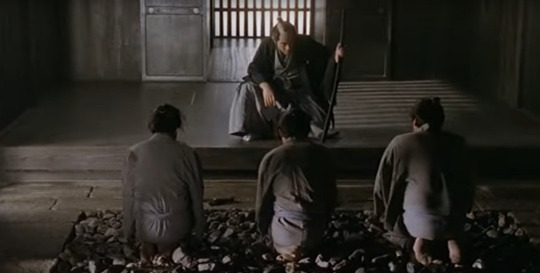
Technically, this is an accurate summary… of the film’s prologue. The actual story is significantly more convoluted—and I mean that as a compliment. The narrative is an intricately constructed puzzle that constantly reassembles, reconfigures, and recontextualizes itself; every scene introduces new characters, complications, and even entire subplots. If you ever find the subject matter objectionable or distasteful, just wait; the movie will be about something completely different within fifteen minutes.
This unconventional structure would be infuriatingly disjointed—were the central themes not so elegantly cohesive and clearly articulated. Like all of Gosha’s work in the chanbara genre, Death Shadows is staunchly antiauthoritarian, condemning any man that would abuse his power—including the secretive spymaster that “recruits” the eponymous assassins. After all, the corrupt clan officials, greedy merchants, and bloodthirsty gangsters that manipulate, exploit, and discard their subordinates deserve to be punished—but exceeding the limitations of the law in order to deliver “justice” is equally unethical (especially when this “necessary evil” is motivated by pragmatism rather than morality).
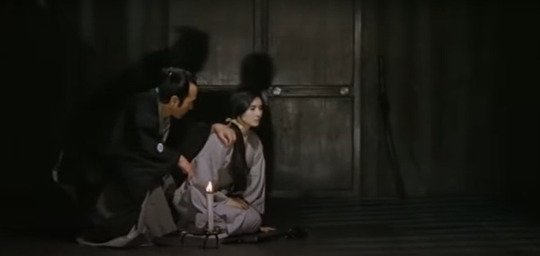
Beyond its deliberately puply premise, Death Shadows also represents the pinnacle of Gosha’s craftsmanship: this is the director’s style at its most economical, purposeful, and precise. He favors long, continuous, unbroken takes, repositioning the camera and performers to seamlessly transition from master shot to coverage (yes, this is very similar to Spielberg’s modus operandi)—a gracefully choreographed ballet that strikes a delicate balance between theatrical mise-en-scène and cinematic composition.
Gosha’s relatively restrained blocking and framing stand in stark contrast to the film’s unapologetically maximalist imagery. Much of the action unfolds on elaborately designed studio sets; hand-painted backdrops depict impressionistic sunsets and overcast skies, creating a surreal, hypnotic, dreamlike atmosphere—a dramatic departure from the grounded, gritty, naturalistic tone of the auteur’s earlier jidaigeki efforts (Three Outlaw Samurai, Sword of the Beast).
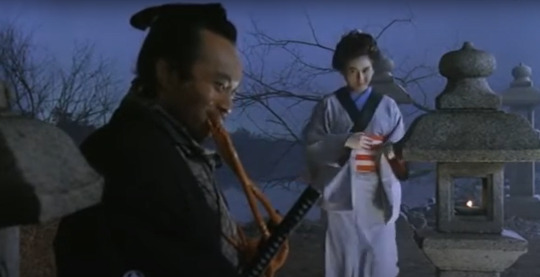
Thus, Death Shadows is a beautiful contradiction; serving as both the culmination of Gosha’s previous accomplishments in the industry and an evolution of his artistic vision, it resides comfortably at the intersection between avant-garde experimentation and popcorn entertainment.
#Death Shadows#Death Shadow#Hideo Gosha#chanbara#chambara#jidaigeki#jidai-geki#Japanese film#Japanese cinema#Criterion Channel#film#writing#movie review
7 notes
·
View notes
Text
Zatoichi, o Samurai (Zatoichi kenka-tabi, 1963), dir. Kimiyoshi Yasuda.
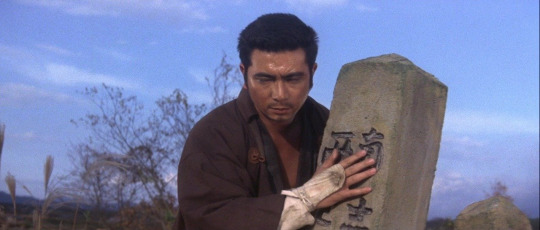



Review originalmente postada: 26/Fev/2023 no Letterboxd.
A cada filme o Zatoichi fica mais carrancudo, neste quinto filme foi explorado uma das tropes que mais gosto e nos dias de hoje, está ainda mais popular: O personagem carrancudo que é posto sem querer para proteger alguém mais frágil. Acabou que vimos concomitante uma versão perversa e compassiva do Ichi. Está dualidade depende de cada pessoa que o interage com o personagem, para um amigo ou alguém que está protegendo, um ser sensível aparece, e para os inimigos, um ser dissimulado e impiedoso. Outro ponto do filme, é a questão social, onde mesmo pessoas que seguiam caminhos honestos, acabam se tornando desprezíveis por causa da ganância provocada pela pobreza. Creio que seja dos primeiros filmes, o que mais discute essa questão. Por causa da evolução do personagem para um ser mais carrancudo, este filme tem as cenas de ação mais violentas comparado aos outros.
#Zatoichi On the Road#Zatoichi#Shintaro Katsu#jidaigeki#chambara#samurai#yakuza#Daiei Film#movie#japan movies#movies#cinema#japan cinema#japanese cinema
1 note
·
View note
Text

Marazhai and my Rogue Trader, but in a 50s Japanese Chambara film🍶
The inspiration came from the famous Japanese cult movie 修羅雪姫(1973) which I like very much! The subtitle is from 椿三十郎(1962)🪭
#illustration#marazhai#marazhai aezyrraesh#rogue trader#commission#marazhai rogue trader#rogue trader fanfiction
118 notes
·
View notes
Text
Palace & Boss BGMs semi-analysis (2/2)
Action! -Another-: It’s slow, intimidating crawl, and underscore of violins gives the impression of menace and threat. “Action!” As a title is likely a reference to the supposed genre of Shadow Miyazawa’s movie, Samurai Action or Chambara. Action!: After the opening section that acts as an uptempo version of Miyazawa’s another version, the song very quickly shifts into a more “modern” version by adding a drum backing and a guitar, and rapidly switching between the two, perhaps showing Miyazawa’s distaste for “authenticity” by way of using less traditional instruments. Vs. Shadow Miyazawa: like how Action! opened with a more “traditional” version of itself, the boss theme has a more traditional opening, but very quickly drops the traditional aspect and becomes almost completely modern instruments again possibly symbolizing Miyazawa’s abandonment of “authenticity” and preference of theatrics and appearance. The intensity of the song may also reflect Miyazawa’s vanity, his insistence that’s he’s the hero protagonist.
Yeah, I agree with all of your takes here! I think you've largely hit the nail on the head... though I would point out that "Action!" is even more obviously just the stereotypical thing for a director to say when filming begins, so while it may also be referencing the genre, I'd honestly just assume it's meant to tie into the fact that the Palace is a movie set, haha.
2 notes
·
View notes
Text
Top 10 Most Searched Christmas Gifts on Amazon
Unwrap the Most-Wanted Presents for 2023
The holiday season is upon us, and it's time to start thinking about gifts for your loved ones. If you're not sure where to start, don't worry. We've rounded up the top 10 most searched Christmas gifts on Amazon right now, so you can find the perfect present for everyone on your list.
1. Amazon Echo Dot (5th Gen)
The Amazon Echo Dot (5th Gen) is a popular smart speaker that can be used to play music, set alarms, get news and weather updates, and control smart home devices. It is one of the most popular items on Amazon this year, with over 10 million searches.

2. Apple AirTag
The Apple AirTag is a small, lightweight tracker that can be attached to keys, wallets, bags, or other items. It can be used to track lost items using the Find My app on iPhone, iPad, or Mac. It is a great gift for anyone who always loses their things.

price on Amazon
3. Tile Mate
The Tile Mate is another popular item tracker that is similar to the Apple AirTag. It can be used to track lost items using the Tile app on iPhone, iPad, or Android devices.

4. Nintendo Switch Sports
Nintendo Switch Sports is a collection of six sports games that can be played with friends and family. The games include tennis, bowling, badminton, soccer, chambara (swordplay), and volleyball. It is a great gift for active families.

price on Amazon
5. LEGO Star Wars: The Skywalker Saga
LEGO Star Wars: The Skywalker Saga is a new video game that tells the story of all nine Star Wars Skywalker Saga films. It features updated graphics, new gameplay mechanics, and a massive open world to explore. It is a great gift for any Star Wars fan.

price on Amazon
6. 5-Minute Crafts DIY Slime Kit
This DIY slime kit is a great gift for kids who love to get creative. It comes with everything you need to make your own slime, including glue, borax, food coloring, and glitter.
price on AMAZON
7. Play-Doh Modeling Compound 24-Pack
Play-Doh is a classic toy that has been enjoyed by kids for generations. This 24-pack comes with a variety of colors, so kids can create all sorts of fun shapes and figures.

price on Amazon
8. L.O.L. Surprise! OMG Neonlicious Fashion Doll with Surprise Accessories
L.O.L. Surprise! dolls are always popular, and this Neonlicious fashion doll is no exception. It comes with a variety of surprise accessories, including clothes, shoes, and jewelry.

price on Amazon
9. Barbie Dreamhouse Playset
The Barbie Dreamhouse is a classic toy that has been a staple of many kids' bedrooms for years. This playset comes with a variety of features, including a pool, a slide, and a working elevator.

Price On Amazon
10. Melissa & Doug Wooden Animal Counters Set
This set of wooden animal counters is a great way for kids to learn about animals. It comes with 24 different animal counters, including lions, tigers, bears, and elephants.

price on Amazon
These are just a few of the many popular Christmas gifts that are being searched for on Amazon right now. With so many great options to choose from, you're sure to find the perfect gift for everyone on your list.
Happy shopping!
#smarthome#giftforanyone#bestseller#losttracker#giftforkids#familygame#starwars#videogame#diykit#slime#classictoy#playdoh#giftforgirls#doll#educationaltoy#animals#christmasshopping#techgifts#crismas gift#crismas gift idea
0 notes
Text
Shakespear, Kabuki e o Haraqiri.
Por: Fred Borges
Em homenagem a todos que partiram sem se despedir na pandemia
Palavras chave: Kabuki 歌舞伎;Shinjyuu 心中; Aokigahara (青木ヶ原);Seppuku 切腹;wakizashi (Kanji: 脇差 Hiragana: わきざし
Estavam ambos sentados um em frente ao outro. Não se encaravam. Os olhos estavam direcionados as xícaras de chá de jasmim.
Uma névoa( 靄
Moya) provavelmente do calor da água fervente embaçava visão, os óculos e os olhos de um e do outro.
Estavam decididos, decisivo foi o desemprego causado pela pandemia.
O silêncio imperava. Estavam ambos preparados. Como num teatro Kabuki, contrariando o governo, haviam decidido terem dividido a árdua e orgulhosa tarefa do punhal penetrando direto no coração.
A hipocrisia e cinismo social os impedia e os impelia a aludida alusão, desilusão a decisão.
A decisão final, fatal, cabal, da cabala judaica oriental, o shinjyuu, eram desconhecidos, conhecida e reconhecida só a cumplicidade do ato final.
Haviam lido, estudado, planejado todo o início dos seus fins,enfim, todo o processo, do jejum,banho,higiene, ao tipo de arma branca, nunca branda, a lâmina afinada e afiada, a empunhadura, postura,a firmeza, a arte, os cantos que deveriam cantar diante do chá,e da mesa.
O Kintsukuroi (金 kin = ouro | 継ぎ tsugi = emenda) poderia ser a solução,mas a decisão já havia sido tomada.
Jasmim era o chá- Suas propriedades para saúde são muito conhecidas por aliviar o estresse; diminuir a ansiedade, a tensão e a exaustão nervosa.
Ajudaria a combater os sintomas da depressão, é excelente calmante e favorece o sono tranquilo.
Sono eterno.
Sono de sonhos de Akira Kurosawa e pesadelos também.
Estavam determinados, leram a história e os fundamentos do Kabuki, tinham visto os filmes de Akira Kurosawa , tinham visto sua ascenção e declínio, seu drama e direção dos seus filmes,de introdutor do gênero chambara
チャンバラ ou (samurai) no cinema, com temas como a honra acima de tudo.
Da sua biografia,sofrendo de fadiga mental em 1971, tentou frustradamente suicidar-se cortando os pulsos por mais de trinta vezes.
Sabia que Akira e agora( 今
Ima)precisavam e tinham a disciplina de celebrar suas origens culturais, afinal era uma vergonha e uma afronta a honra e dignidade estarem ambos desempregados.
Haviam lido que o primeiro harakiri registrado na história data de 1170, quando Minamoto Tametomo, figura quase lendária do clã Minamoto, suicida-se após perder uma batalha contra o também famoso clã dos Taira.
O suicídio ritual ainda tem e tinha antigamente grande significado para o povo japonês.
Vencendo o medo da morte, o samurai vencia também esse grande enigma da humanidade, "ser ou não ser eis a questão", e destacava-se então das outras classes existentes na época.
É esse mesmo espírito do samurai que levaram os pilotos suicidas (kamikases) a explodirem junto aos seus aviões durante a Segunda Guerra Mundial.
Impensável, imponderável, inadmissível ao mundo ocidental, ao microscópico universo americano.
Inserido a este contexto temos o kabuki (歌舞伎?) ou cabúqui que é uma forma de teatro japonês, conhecida pela estilização do drama e pela elaborada maquilhagem utilizada pelos seus atores.
O significado individual de cada ideograma é canto (ka) (歌), dança (bu) (舞) e habilidade (ki) (伎), e por isso a palavra kabuki é por vezes traduzida como "a arte de cantar e dançar".
Esses ideogramas, entretanto, são o que se chamam de ateji (ideogramas usados apenas com sentido fonético) e não refletem a mesma etimologia da palavra.
Acredita-se, de fato, que o kabuki derive do verbo kabuku, significando aproximadamente "ser fora do comum", donde se depreende o sentido de teatro de "vanguarda" ou teatro "bizarro".
Algo " fora do comum" aconteceu e acontece até hoje na pandemia e suas externalidades.
A sua origem remonta ao início do século XVII, quando se parodiavam temas religiosos com danças de ousada sensualidade para uma sociedade tradicional e conservadora na época e até hoje.
Lá o certo é o correto e íntegro ou moralmente e eticamente coerente.
No ano de 1629, esse tipo de teatro foi proibido pelo governo.
O espetáculo passou a ser encenado então por rapazes que interpretavam papéis femininos.
Contemporaneamente, o teatro kabuki tornou-se um espectáculo popular que combina realismo e formalismo, música e dança, mímica, encenação e figurinos, implicando numa constante integração entre os atores e a plateia de significado cultural.
Logo, os dois, sentados diante do chá, adotaram a pintura de morte e vida divergente e convergente, yin e yang nas suas faces, espelhos e cores azuis foram colocados no pequeno apartamento, um paradoxo universal entre a vida e a morte.
Leram sobre a adversidade causada pelas mulheres no Kabuki, e um se vestiu de vida e o outro da morte,homem e mulher,mas ambos eram homens, ambos tinham o mesmo objetivo e meta- dar fim a vida.
O local estava frio, o chão estava quente, as armas brancas e nunca brandas, suas lâminas estavam preparadas, lavadas com água da nascente do monte Fugi( 富士山) para o ritual.
Não haveria o papel coadjuvante do kaishakunin, não haveria o kimono branco, não haveria glória, seria uma tragédia Shakespeariana aos olhos ocidentais, olhos de um Romeu e uma Julieta, seria a negação da vida, do amor, pela morte.Seria o encontro na posteridade com a paz.
Diria Romeu: “Minha generosidade é tão ilimitada quanto o mar,
Meu amor é tão profundo; quanto mais te dou,
mais tenho, pois ambos são infinitos.”
No lugar disto recitariam o poema da morte dos Samurais:
"Não serei para ti um fardo pesado,
Nem permitirei que se ponham contra mim.
Pai... Veja como eu sangro!
As minhas escolhas levaram-me a perambular
Num labirinto de espinhos...
Todos estes anos eu estive perdido.
Minhas vestes brancas estão vermelhas,
Porém meus punhos e tornozelos
Não serão por grilhões feridos.
Lutei a vida toda em nome da honra
E hoje por meu orgulho fui vencido.
Eu não descansarei em campos floridos,
Serei jogado em terreno incerto...
Lá onde as cadelas vorazes dilaceram os pródigos
E as arvores sangram e choram o pranto dos suicidas.
Pai eu estou sangrando... Pai eu estou ferido!
E logo os meus inimigos irão me encontrar,
Não deixarei que me tomem prisioneiro
Eles não conseguirão me escravizar.
A espada que um dia me salvou
Será a arma que irá me sentenciar,
Adeus ó amigos... Adeus ó pátria
O teu filho a ti não retornará"
Assim tomam o chá e enfiam a katana um no coração do outro, o chão branco fica vermelho, a vida é infinitamente tão frágil...
FIM.






0 notes
Text
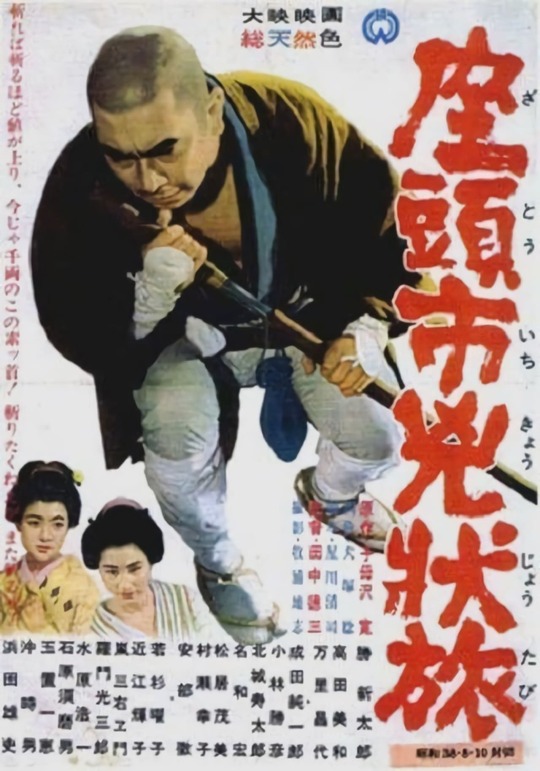



W A T C H I N G
#ZATOICHI THE FUGITIVE (1963)#SHINTARO KATSU#WATCHING#座頭市兇状旅#Zatōichi Kyōjō tabi#Miwa Takada#Sachiko Murase#Masayo Banri#Junichiro Narita#Katsuhiko Kobayashi#Toru Abe#Koichi Mizuhara#Jutaro Hojo#Hiroshi Nawa#Koichi Mizukami#Yasuhiro Mizukami#Samurai#ronin#yakuza#Chambara film#Jidaigeki#Jidaigeki film
1 note
·
View note
Text










DAIMAJIN 大魔神 4K RESTORATION (1966)
KADOKAWA Blu-ray set 2021
#大魔神#daimajin#kadokawa#daiei#4k restoration#blu-ray#physical media#tokusatsu#godzilla#chambara#god#demon#film#gallery#movie#gamera#import#Miwa Takada#高田 美和#The Devil Got Angry#The Vengeance of the Monster#Majin#Majin the Monster of Terror#Daiei Film#Kimiyoshi Yasuda#安田公義
163 notes
·
View notes
Text

Some unlucky samurai trying their luck against the nigh-unstoppable ronin, Nemuri Kyōshirō.
21 notes
·
View notes
Photo











































Zatoichi's Vengeance
173 notes
·
View notes
Text

Shogun's Shadow, Yasuo Furuhata
#shogun's shadow#yasuo furuhata#1989#1980s#80s#samurai#chambara#Shôgun Iemitsu no ranshin#将軍家光の乱心 激突#movie#film#cinema#japan#japanese#screencaps#stills
0 notes
Text
Recently Viewed: Samurai Wolf

In Samurai Wolf, director Hideo Gosha shaves his already minimalistic chanbara formula all the way down to the bone. Although conspiracies, intrigue, conflicting loyalties, and double identities abound, these recurring tropes merely provide narrative context rather than serving as central themes. The setting is likewise quite modest compared to the lavish, densely populated feudal cities and quaint, fertile farms that tend to define the jidaigeki genre; the story instead unfolds in a remote ghost town nestled amidst an imposing mountain range, where the ramshackle buildings and dusty, desolate roads evoke an almost post-apocalyptic atmosphere. Even the heroic ronin du jour lacks his archetype’s trademark tragic origin, swaggering onto the screen pretty much fully formed, with only the clothes on his back (his frequent shirtlessness notwithstanding).
The simple, straightforward, no-frills plot allows Gosha to focus his creative energies on what truly matters: the style. Every image is a beautifully crafted work of art. The action is, of course, exquisitely choreographed, making excellent use of slow motion, precise editing, and dynamic framing (including claustrophobic closeups, sprawling wides, and disorienting Dutch angles) to add variety to the intentionally chaotic battles. Expository dialogue is filmed with equal care and attention to detail. In one early scene, for example, our protagonist negotiates with a prospective employer while casually trimming his beard, using his sword as a makeshift mirror; thus, both characters remain visible in each shot/reverse shot via the reflective surface of the blade, lending visual flair to the otherwise basic compositions.
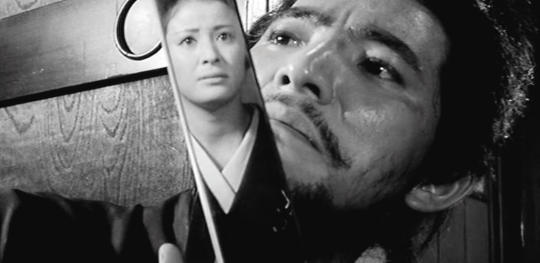
Samurai Wolf isn’t Gosha’s best movie (that title rightfully belongs to either Three Outlaw Samurai or Hunter in the Dark, despite my personal preference for Sword of the Beast), but it certainly ranks among his most effortlessly entertaining. Running a lean, breezy seventy-five minutes without sacrificing any of its emotional resonance, it proves the old adage, “Sometimes, less is more.”
#Samurai Wolf#Hideo Gosha#Film Movement#Japanese cinema#Japanese film#jidaigeki#jidai-geki#chanbara#chambara#samurai movie#film#writing#movie review
4 notes
·
View notes
Photo
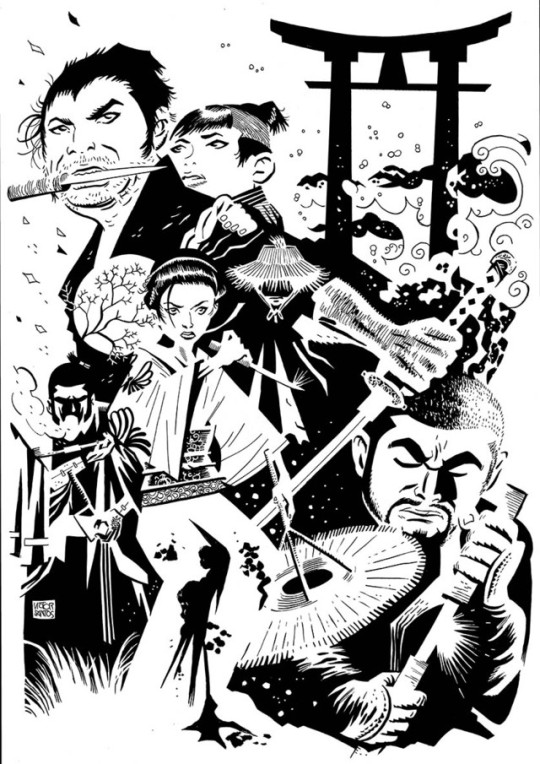
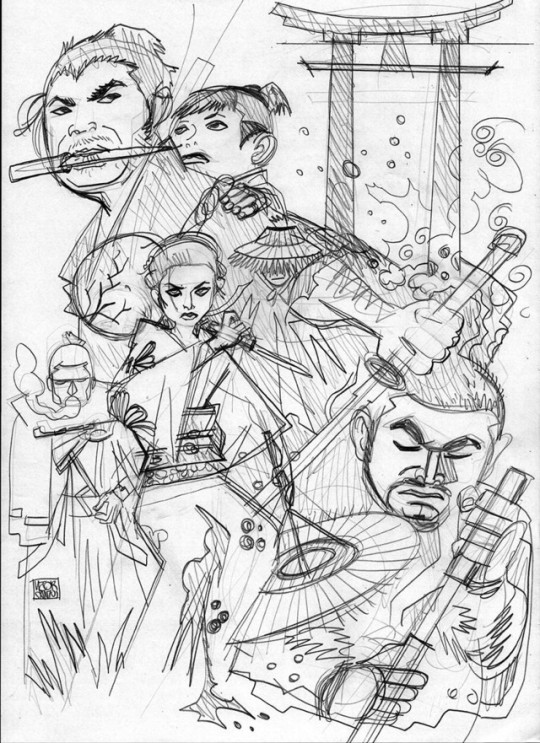
Homenaje a las pelis de samurais japonesas (Chambara) con el Lobo Solitario y su Cachorro, Lady Snowblood, Zatoichi y el personaje Heigo Kobayashi de mi propia novela gráfica Rashomon. / Tribute to the Japanese Samurai films (Chambara) with Lone Wolf & Cub, Lady Snowblood, Zatoichi and the character Heigo Kobayashi from my Rashomon graphic novel ENCARGOS/ COMMISSIONS http://victorsantoscomics.blogspot.com.es/p/prices-for-guidance-inked-210-x-297-mm.html RASHOMON: https://www.darkhorse.com/Books/28-126/Rashomon-A-Commissioner-Heigo-Kobayashi-Case-HC
#zatoichi#lone wolf and cub#lady snowblood#chambara#samurai#samurai films#rashomon#dark horse books#shintaro katsu#meiko kaji#kazuo koike#goseki kojima#commission
26 notes
·
View notes